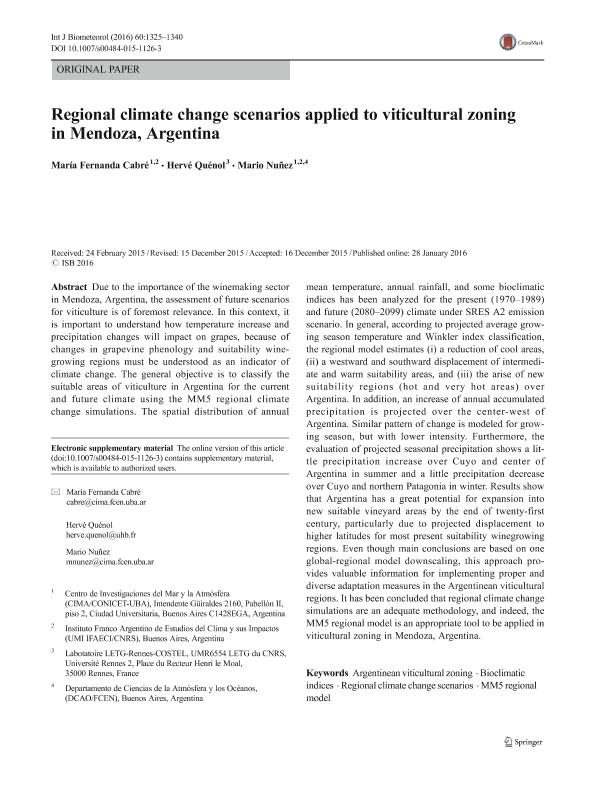Mostrar el registro sencillo del ítem
dc.contributor.author
Cabre, Maria Fernanda

dc.contributor.author
Quénol, Hervé
dc.contributor.author
Nuñez, Mario Nestor

dc.date.available
2018-09-07T19:36:07Z
dc.date.issued
2016-09
dc.identifier.citation
Cabre, Maria Fernanda; Quénol, Hervé; Nuñez, Mario Nestor; Regional climate change scenarios applied to viticultural zoning in Mendoza, Argentina; Springer; International Journal Of Biometeorology; 60; 9; 9-2016; 1325-1340
dc.identifier.issn
0020-7128
dc.identifier.uri
http://hdl.handle.net/11336/58818
dc.description.abstract
Due to the importance of the winemaking sector in Mendoza, Argentina, the assessment of future scenarios for viticulture is of foremost relevance. In this context, it is important to understand how temperature increase and precipitation changes will impact on grapes, because of changes in grapevine phenology and suitability wine-growing regions must be understood as an indicator of climate change. The general objective is to classify the suitable areas of viticulture in Argentina for the current and future climate using the MM5 regional climate change simulations. The spatial distribution of annual mean temperature, annual rainfall, and some bioclimatic indices has been analyzed for the present (1970–1989) and future (2080–2099) climate under SRES A2 emission scenario. In general, according to projected average growing season temperature and Winkler index classification, the regional model estimates (i) a reduction of cool areas, (ii) a westward and southward displacement of intermediate and warm suitability areas, and (iii) the arise of new suitability regions (hot and very hot areas) over Argentina. In addition, an increase of annual accumulated precipitation is projected over the center-west of Argentina. Similar pattern of change is modeled for growing season, but with lower intensity. Furthermore, the evaluation of projected seasonal precipitation shows a little precipitation increase over Cuyo and center of Argentina in summer and a little precipitation decrease over Cuyo and northern Patagonia in winter. Results show that Argentina has a great potential for expansion into new suitable vineyard areas by the end of twenty-first century, particularly due to projected displacement to higher latitudes for most present suitability winegrowing regions. Even though main conclusions are based on one global-regional model downscaling, this approach provides valuable information for implementing proper and diverse adaptation measures in the Argentinean viticultural regions. It has been concluded that regional climate change simulations are an adequate methodology, and indeed, the MM5 regional model is an appropriate tool to be applied in viticultural zoning in Mendoza, Argentina.
dc.format
application/pdf
dc.language.iso
eng
dc.publisher
Springer

dc.rights
info:eu-repo/semantics/openAccess
dc.rights.uri
https://creativecommons.org/licenses/by-nc-sa/2.5/ar/
dc.subject
Argentinean Viticultural Zoning
dc.subject
Bioclimatic Indices
dc.subject
Mm5 Regional Model
dc.subject
Regional Climate Change Scenarios
dc.subject.classification
Meteorología y Ciencias Atmosféricas

dc.subject.classification
Ciencias de la Tierra y relacionadas con el Medio Ambiente

dc.subject.classification
CIENCIAS NATURALES Y EXACTAS

dc.title
Regional climate change scenarios applied to viticultural zoning in Mendoza, Argentina
dc.type
info:eu-repo/semantics/article
dc.type
info:ar-repo/semantics/artículo
dc.type
info:eu-repo/semantics/publishedVersion
dc.date.updated
2018-09-07T13:46:54Z
dc.journal.volume
60
dc.journal.number
9
dc.journal.pagination
1325-1340
dc.journal.pais
Alemania

dc.journal.ciudad
Berlin
dc.description.fil
Fil: Cabre, Maria Fernanda. Consejo Nacional de Investigaciones Científicas y Técnicas. Oficina de Coordinación Administrativa Ciudad Universitaria. Centro de Investigaciones del Mar y la Atmósfera. Universidad de Buenos Aires. Facultad de Ciencias Exactas y Naturales. Centro de Investigaciones del Mar y la Atmósfera; Argentina. Instituto Franco Argentino de Estudios del Clima y sus Impactos; Argentina
dc.description.fil
Fil: Quénol, Hervé. Université Rennes 2; Francia
dc.description.fil
Fil: Nuñez, Mario Nestor. Consejo Nacional de Investigaciones Científicas y Técnicas. Oficina de Coordinación Administrativa Ciudad Universitaria. Centro de Investigaciones del Mar y la Atmósfera. Universidad de Buenos Aires. Facultad de Ciencias Exactas y Naturales. Centro de Investigaciones del Mar y la Atmósfera; Argentina. Instituto Franco Argentino de Estudios del Clima y sus Impactos; Argentina. Departamento de Ciencias de la Atmósfera y los Océanos; Argentina
dc.journal.title
International Journal Of Biometeorology

dc.relation.alternativeid
info:eu-repo/semantics/altIdentifier/doi/https://dx.doi.org/10.1007/s00484-015-1126-3
dc.relation.alternativeid
info:eu-repo/semantics/altIdentifier/url/https://link.springer.com/article/10.1007/s00484-015-1126-3
Archivos asociados
